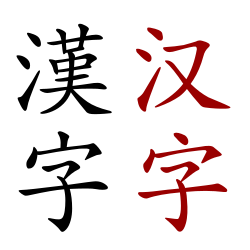Wikipedia:2008 main page redesign proposal/h2g2bob
The free encyclopedia that anyone can edit.
About Wikipedia – Help – How to edit – Where to ask questions
Today's Featured Article
Chinese characters are logographs used to write the Chinese languages and others from regions influenced by Chinese culture. The function, style, and means of writing characters have changed greatly over the past three millennia. Unlike letters in alphabets that directly reflect the sounds of speech, Chinese characters generally represent morphemes—the units of meaning in a language—often encoding aspects of pronunciation as well as meaning. Writing all of a language's frequently used vocabulary requires 2000–3000 characters; as of 2024, nearly 100,000 have been identified and included in The Unicode Standard. Characters are composed of strokes written in a fixed order. Historically, methods of writing them include inscribing stone, bone, or bronze; brushing ink onto silk, bamboo, or paper; and printing with woodblocks or moveable type. More recent technologies using Chinese characters include telegraph codes and typewriters, as well as input methods and text encodings on computers. (Full article...)
In the news
- Author Banu Mushtaq and translator Deepa Bhasthi win the International Booker Prize for Heart Lamp: Selected Stories.
- Nicușor Dan (pictured) is elected as president of Romania.
- In the Portuguese legislative election, the Democratic Alliance wins the most seats in parliament.
- Austria, represented by JJ with the song "Wasted Love", wins the Eurovision Song Contest.
- In the Philippines, the Alyansa para sa Bagong Pilipinas wins the most seats in the Senate election, while Lakas–CMD, one of its component parties, wins the most seats in the House elections.
Search 6,997,681 articles
in English (other languages)
Browse Wikipedia
Sister projects
Wikipedia is hosted by the Wikimedia Foundation, a non-profit organization that also hosts a range of other projects:
- Commons
- Free media repository
- Wikinews
- Free-content news
- Wiktionary
- Dictionary and thesaurus
- Wikiquote
- Collection of quotations
- Wikibooks
- Free textbooks and manuals
- Wikisource
- Free-content library
- Wikispecies
- Directory of species
- Wikiversity
- Free learning materials and activities
- Meta-Wiki
- Wikimedia project coordination
Picture of the Day

|
Germanicus Julius Caesar (24 May 15 BC – 10 October AD 19) was an ancient Roman general and politician most famously known for his campaigns against Arminius in Germania. The son of Nero Claudius Drusus and Antonia Minor, Germanicus was born into an influential branch of the patrician gens Claudia. The agnomen Germanicus was added to his full name in 9 BC when it was posthumously awarded to his father in honor of his victories in Germania. In AD 4 he was adopted by his paternal uncle Tiberius, himself the stepson and heir of Germanicus' great-uncle Augustus; ten years later, Tiberius succeeded Augustus as Roman emperor. As a result of his adoption, Germanicus became an official member of the gens Julia, another prominent family, to which he was related on his mother's side. His connection to the Julii Caesares was further consolidated through a marriage between him and Agrippina the Elder, a granddaughter of Augustus. He was also the father of Caligula, the maternal grandfather of Nero, and the older brother of Claudius. This bust, depicting Germanicus in AD 4, is in the collection of the J. Paul Getty Museum. Sculpture credit: unknown; photographed by J. Paul Getty Museum
Recently featured:
|


